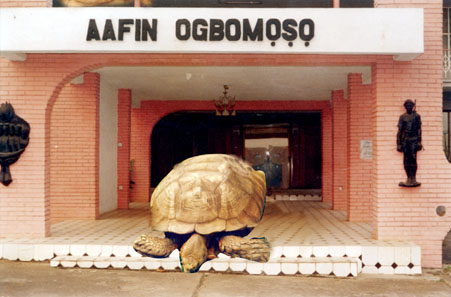
Tourism is not complete in Oyo State without a reference to Alagba – a giant male land tortoise believed to have lived in the palace of the king of Ogbomoso for 324 years. EMMANUEL ONYECHE, who visited the palace recently, examines the age issue of this ancient animal and the myths woven around it. THE primeval town of Ogbomoso, the second largest city in Oyo State, has an ancient resident – a giant male land tortoise, which is acclaimed to have lived in the palace of the Soun (the king) of Ogbomosoland for 324 years.
In deference to its age, it is called Alagba, which means ”the elderly one” in Yoruba. And, in Ogbomoso, where the legendary tortoise lumbers about in the palatial grounds of the king, it is almost a sacrilege to refer to Alagba as a mere tortoise.
Since Alagba is believed to be older than everyone in Ogbomoso, permutations about its true age relies heavily on oral history. Its present age was arrived at by situating it with the period of the Soun who reigned then. Alagba was allegedly brought to the palace by Soun Ikumoyede Ajao, the third Soun of Ogbomoso, who is believed to have been born sometime in the late 16th century and who reigned in the 17th.
Mr. Ajamu Oluwatoyin, the secretary of the current Soun says dating of the kingship of Ogbomoso was started by the elite in 1797 during the reign of Oba Toyeje Akanni (1797 to 1825), the fourth Soun and one time Are Ona Kakanfo (the Yoruba Nation Generalissimo).
Since it was customary in those days to transfer the property and all palace belongings to the new monarch, Alagba had allegedly remained in the palace till date.
According to IBKay‘s blog on the Internet, the reigning Oba Oladunni Oyewunmi, Ajangungbade III, the 20th Soun, who has been reigning since 1974, confirmed that he knew the tortoise while he was a child-prince.
Mr. Adeniyi Alabi, Kakaki Oba (the oba‘s praise singer) and Mr. Adeyanju Areo, who used to carry the umbrella that shields the oba from the sun, also carry out the oba‘s instructions to take care of Alagba. They say the animal drinks water once in two weeks and that when it does, it finishes a 25-litre bucket.
Alagba is said to eat everything that human beings eat but likes pawpaw particularly. It is said to detest heat and plays a lot in the rainy season. Alabi and Areo put Alagba‘s weight at approximately 100kg since, according to them, its weight is equivalent to two bags of cement and it requires four men to lift it up.
”No matter how heavy you are, Alagba will carry you on its back and be moving about,” Areo says and adds that the incumbent oba, who cares so much about the well-being of Alagba, was the one that stopped people from climbing the back of the animal as the animal was getting old.
Mr. Muphtau Owolabi, the police orderly to the oba said three years ago, Alagba was sick and required surgery on its neck. Doctors put its survival chances at 50 per cent. The oba was said to have not permitted the surgery and Alagba later recovered.
Like some items in African traditional palaces that exist for mystical purposes, Areo says Alagba‘s existence in the palace has no such inclination. ”Alagba is just an aged animal that is well taken care of by the kabiyesi. There are vet doctors that attend to it and they give us drugs that we put in the water it drinks and the food it eats”, Areo says.
Nevertheless, all sorts of myths have been woven around Alagba. ”It hears what people say though it cannot speak,” Alabi says. ”It recognises kabiyesi‘s voice. If kabiyesi calls it Alagba, it will be shaking its head in agreement. Some people also stay near Alagba to offer prayers for longevity.”
A palace source said for a long time since its existence, Alagba was the only being that the king‘s wives may run to for refuge to avoid the anger of their husband.
”Whatever might have been the sacrilege of such a woman, the kabiyesi overlooks it if she runs to Alagba for protection,” she says.
There are also myths that allege that it is a particular oba that had become so old that turned himself to Alagba during a festival in the palace.
Kayode says looking at the body cells and carapace (shell) of Alagba can help determine its true age. ”The carapace is laid on yearly and its ornamentation can help determine the age of the tortoise,” he said.
He was however doubtful of the possibility of any expert in the country undertaking a venture to determine Alagba‘s true age since it would be of no economic value.
When Alabi took our correspondent to Alagba for introduction, he called the being twice saying, ”Alagba, Alagba, you have a visitor.” He spoke Yoruba. The ancient one slowly opened one of its eyes and brought out its neck full of age, spots and thick rough warts.
Slowly, it retreated into its thick shell and went back to sleep, its thoughts as mysterious as its age.
However, Mr. Akinwande Kayode, a lecturer in the Department of Zoology, University of Lagos, Akoka, doubted the veracity of the claims about Alagba‘s age. ”It is not scientific. It is oral evidence and there is no scientific evidence to support it,” he says.
He however states that tortoises generally live longer than other animals and that this is possible because of their link with the dinosaurs. ”Tortoise and turtle belong to the order Chelonians and they are the only living representatives of the order Chelonians which have a close link to the dinosaurs and dinosaurs as ancient animals lived for very long – up to 400 years – and they had enormous size,” he says.
According to Whyzz.com, an online question and answer site on the Internet, most tortoises do not pass 100, some have been known to live well past that marker and have lived as long as 200 to 250 years.
The site gave the reason why tortoises are able to live so long as having a lot to do with how they‘re built and how they live ”Because they are protected by a strong hard shell, tortoises are good at avoiding predators. Tortoises also live and move slowly, which means they use up less energy than lots of other creatures. – If a tortoise is unable to find enough food, they can survive for longer on less more easily than animals who burn through their energy really quickly.”
In March 2006, it was reported that an Aldabra tortoise at the Calcutta Zoo died and was estimated to be 250 years old. A Madagascar radiated tortoise was said to have lived in captivity to at least 188 years. Similarly, a 176-year-old giant tortoise from an Australian Zoo died in June, 2006. Typically, the Galapagos tortoise lives 150 years. Other varieties regularly live to be 100.



















